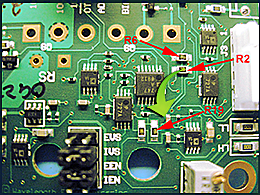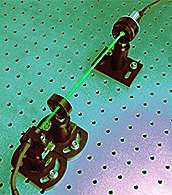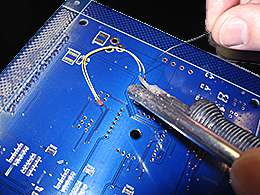
Very well. Often, a customer is price sensitive and wants the product delivered without the final cover. Or connectors instead of terminal strips. Or without potentiometers, just fixed resistors specific to their application. We accommodate these requests through the Product Variation system. You will be assigned a Product Variation number of the form PV###. The PV number will show on the sales order along with the standard product number. We develop an Assembly / Test document that details what needs to be different. This travels with the order through processing. The final product is engraved or labeled with the PV number and the lot number.
Other product variations have included adding wires where a potentiometer would be soldered so the customer could use a remote potentiometer mounted on a front panel. When a lower power laser diode must be upgraded to higher power, we can often modify an existing product to meet the increased current requirements, so the control PCB does not need to change. The PV can be as simple as changing the factory default settings to user defined limit and setpoint. We also install the electronics on custom baseplates.
We manufacture the products in house, so we have complete control over quality and schedule. If you’d like to streamline your assembly time or improve how the controller fits into your system, just talk to your account engineer.
If you would like to request a product variation, please contact Technical Support.

Subscribe to our newsletter for tips, techniques & product updates.
The decision to operate in CC or CP mode depends on the application. We’ll discuss what the modes mean and a few example choices.
In Constant Current mode (CC) the laser diode current source drives a constant current through the laser diode, never varying. Feedback is taken from a resistor in series with the current source.
In Constant Power mode (CP) the laser diode current source increases and decreases current through the laser diode, to keep the feedback from the photodiode constant. The photodiode monitors a fixed portion of the light generated by the laser diode. The laser diode manufacturer can provide a transfer function relating the photodiode current to the laser diode power output [usually with units of mA / mW or µA / mW]. This transfer function can vary wildly from laser diode to laser diode, so the specifications are usually very wide. If operating at a constant, known power is critical, calibrating the photodiode response with an external power meter may be necessary.
In some cases, constant wavelength is critical, but having a wavelength meter provide feedback is not practical. Often, the laser diode is run in Constant Current mode and a thermoelectric is used to keep the die at a constant temperature. The temperature is scanned to achieve the correct wavelength then held constant.
Constant Power may be required if the laser diode is used in a sensing application to illuminate a sample and absorption, reflection, or scatter is being measured. Here the detector senses power, so a constant input power is necessary to maintain calibrated measurements.
Constant Power may also be required in communications applications when signal degradation affects signal to noise ratio and system performance. Laser diodes lose power as they age. More current is required to achieve the same power over time. To insure constant power output, feedback from the integrated photodiode is monitored and the laser diode current source increases its output until it reaches a preset current limit.
Often, a design looks excellent on paper, but when implemented in the field, unexpected limitations are discovered. Thermistor placement, mounting method, and even how it is soldered to control electronics can introduce noise, thermal lag, and inaccuracies to a system. Application Note AN-TC08: Mounting and Soldering Nickel Lead Thermistorsprovides hands-on knowledge of simple but critical implementation issues for temperature control systems.
If you have additional questions, contact Technical Support.
Thank you to all our loyal customers that have made our 20th anniversary possible. We continue to pursue ever better circuitry and packaging to allow you to push the envelope in your field of research and product development. Licensing the patent for low noise QCL drivers and developing a robust field-deployable controller is one example of how we have enabled precision trace gas analysis in many markets. We constantly upgrade our manufacturing facility to excel at ever smaller components to support portable, hand held devices. And we always provide responsive, knowledgeable technical support. Our goal is to establish a win-win partnership with each and every client. Here’s to another twenty years…
We invite you to contribute topic suggestions, questions, and general feedback. Wavelength will incorporate as much reader input as possible.
Click to Submit





